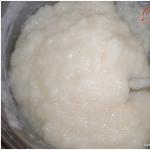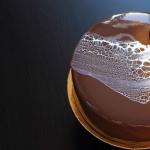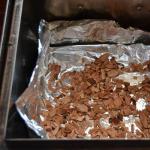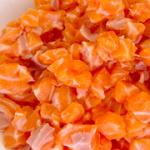Salad with black protein caviar. Imitated caviar What can be prepared from imitation caviar
Making caviar at home is not only an opportunity to please your family with a tasty and nutritious product, but also a great idea for a highly profitable business!
What does it take to make 3(!) kilograms of black granular caviar?
- food gelatin (190 g)
- Milk (1.5 liters, boil)
- Salt (100 gr.)
- Herring “Ivasi” (1.5 kg)
- herring brine (1.5 kg).
On average, this is approximately 100-150 rubles per kilogram, depending on the region in which you live. Now calculate how many times the cost is lower than the prices for natural caviar.
Don’t worry – not every connoisseur will recognize that these are artificial “fish eggs”. The taste of caviar is almost indistinguishable.
We will need a special device that will turn the above products into granules. Its production technology is quite simple.
We take a glass wind tube (you can find it from a fluorescent lamp), you need to install it in a vertical position. The lower end of the tube is hermetically connected to the neck of a 3-liter jar. Don't forget about the drain hole: it is made at the very top, in the wall of the tube. A large syringe with a needle diameter of 0.4 mm is also useful.
The productivity of this installation is at least 3.0 kg/hour of caviar-shaped granules with a diameter of 1-3 mm. Anyone can use this device, everything is quite simple. It can be installed in a minibar, cafe, snack bar.
Making caviar yourself
Pour gelatin with boiled cold water (750 ml). It takes 40 minutes for the gelatin to swell. Then pour all the milk into it and dissolve it all over low heat, stirring gradually. Filter and transfer to a syringe.
Pour cold vegetable oil into the device tube; there should be a few centimeters left before the drain hole. The oil should be cool - no higher than 10 degrees.
Quickly inject the contents of the syringe into the tube. A jet of milk with gelatin hits the oil with force and forms balls with a diameter of 3 mm (the size of the granules is regulated by the injection force). The balls settle to the bottom of the jar, and the oil is pushed out into the drain hole. When the granules stop forming, you need to transfer them to a sieve and use a strong stream of cold water to knock off the oil film from the surface of the granules. The preparation for black caviar is ready!
Tanning and coloring of granules
Place the “balls” in a saucepan, pour in four liters of cold filtered tea (300 grams of black tea per 5 liters of water), tan in this solution for half an hour.
Then we wash everything and place it in a pan with a 0.1% solution of ferric chloride (or other food colorings). After you achieve a dull color, rinse the caviar with cold water.
Finally, pour the granules with a salty solution (0.5 liters of water and 4 tablespoons of salt). Leave for 10 minutes. then drain the solution. Transfer to a container and pour in a flavoring solution (Iwashi-type herring brine) for 15 minutes. Transfer the granules into the herring emulsion (bring 1.5 kg of Iwashi-type herring using a mixer to a homogeneous emulsion) and mix. Drain off excess emulsion after 10 minutes.
The caviar is ready. As you can see, we didn't even need fish. Caviar is perfectly stored in the refrigerator, just grease the top layer with vegetable oil to prevent it from drying out. Bon appetit!
Here's how to make black caviar from seaweed:
Everything is just like that. This recipe and the entire technology were described in the magazine Inventor and Innovator No. 12, 1972. I made the caviar myself. Tube from a fluorescent lamp 1.2 m long, veterinary syringe 200 g. There are minor difficulties with cooling the oil in the tube. I had to spirally wrap the tube with a rubber tube and wrap it with film over it. Then supply cold water from below and drain it from above using rubber tubes (this was the difficulty). Olive or corn oil is best, they are odorless. The know-how is that before you start injecting the composition from a syringe into the oil, you need to pour heated oil into the tube to about 30-40 degrees so that the caviar balls form in the warm oil and then drop into the cooled oil. Otherwise everything is as described. The result was almost real caviar. The whole joke was that before making caviar I had never seen or eaten it. My wife took it to work for her employees to taste. So, if she didn’t tell anyone that the caviar was homemade, then everyone was delighted, and if she told anyone that it was homemade, then everyone found some kind of discrepancy.
What is a wind glass tube? And how can it be secured to the jar? Draw a diagram
It’s clear that THIS is not even close to real caviar... BUT isn’t it interesting to experiment and try to achieve at least an approximate taste yourself... and then... for a snack, I and the men will eat such caviar with a bang..... and I won’t even hide it.... why What distinguishes it there is... any caviar... it bursts between the teeth... and the gelatin is clear. I don’t need an expert to chew here... but I want to try it to really make it taste fishy.....and the device that is described here. I don’t understand what kind of bullshit... the description is similar to how three blind men felt an elephant... one felt his leg. second tail. and the third trunk... throw a link on the device.
I’ll try to explain the device for obtaining caviar. We roll up a 3-liter bottle with a lid for preservation. On the lid we first cut a hole for soldering a tube, 3-4 cm long. The diameter of this tube should correspond to the diameter of the glass tube. The most accessible option is to take a burnt-out fluorescent lamp. Trim the base ends. We connect the tube to the jar with an ordinary hose up to 10 cm long. To prevent the oil in the tube from overheating, we do additional cooling by wrapping an ordinary vinyl chloride tube with a diameter of 6-8 mm around the glass tube along the entire length of the glass tube. We fix it all with tape. We connect the lower end of the vinyl chloride tube to the mixer, and the upper end should reach the sink (drain). As needed, open the cold water tap slightly and the oil cools in the glass pipe. You also need to ensure the vertical position of the glass tube using a stand: under the jar there is a piece of board, to the board there is a “lining” of the required length, and to the “lining” there is a piece of wood to which and you need to attach the top part of the glass tube. That's all ready for the production of the “delicacy”
Fake caviar (recipe No. 1)
The recipe is very old, my mother used to give me these sandwiches to school! Great appetizer and overall just delicious!
Ingredients:
The main thing here is that the fish has caviar! This is the secret of the recipe. We sell herring caviar separately... but in my case - 1 herring with caviar,
half a glass of semolina,
1 small onion
1 tablespoon red pepper,
3 tablespoons olive oil,
2 tablespoons vinegar.
I put the finished caviar in an airtight jar, and it is stored for a week without problems, instead of pate for my dear soul!
Preparation:
Cook the semolina until it reaches a spoon-like consistency in the water, add a little salt, it is very important that it COOL COMPLETELY! 
We clean the herring, separate it from the skin, I also cut off the bellies with bones... I don’t like them.... ;) and wash them thoroughly along with the caviar 
Then we pass the caviar, herring and onion through a meat grinder 2!! times 
Combine all the ingredients, semolina mixture of herring and onions, pepper, vinegar and oil... and mix thoroughly. The finished mass can be put into jars and eaten on bread. 
Delicious! I recommend you try it! And the caviar crunches on your teeth, it feels like you are eating real caviar... hence the name, fake! :)))))
Author bastet
Appetizer "False caviar" (recipe No. 2) 
This is the most delicious spread I've ever tried. The taste is very reminiscent of red caviar, it always goes with a bang! My mother “brought” the recipe from a guest many years ago, and now we have this paste very often!!
Ingredients:
* 1 herring
* 100-150 g butter
* 2 processed cheese
* 3 small carrots
Preparation:
Clean the herring from entrails, skin and bones. Boil carrots until tender.
Twist the herring, carrots, butter, and cheese through a meat grinder and stir. The spreader is ready.
Store in the refrigerator for up to 5 days (I don’t know exactly, I’ve never kept it that long).
You can spread it on bread, a loaf, on slices of boiled or baked potatoes, stuff eggs, cucumbers, and tomatoes.
I conducted an experiment several times, gave him a bite of a piece of sandwich and asked me to say what it was with, everyone unanimously said, of course, with red caviar!!
So it's cheap and cheerful, but delicious.... Try it!!
Recipe author nikulj Photo author Nadinka
False caviar 2 (recipe No. 3) 
And another interesting and tasty putty for sandwiches
Ingredients:
2-3 boiled carrots,
1 herring,
100 gr. butter,
2 processed cheese
two hard-boiled eggs. 
Preparation:
By definition, I don’t have a meat grinder; I always use a food processor with knives. Here it is more convenient for someone.
So, put all our ingredients in the bowl 
and grind until smooth 
You can add salt to taste if the herring is lightly salted.
Spread it on the bun and drink tea :) 
We put the leftovers in the refrigerator for the future :) 
Bon appetit!
Product Description
Imitated caviar is an inexpensive fake of real fish caviar, black or red. This product is generally harmless - except when the ingredients contain synthetic rather than natural dyes.
Synthetic caviar produced not from oil or anything else completely inedible, as many people think, but from substances obtained from seaweed - agar, agaroid, alginate. They make jelly from which eggs are formed. That is why artificial caviar is easy to distinguish from real caviar by taste. Real eggs have liquid contents and a shell that bursts when pressed. Imitated eggs are homogeneous in structure and are simply chewed. The advantage of artificial caviar is its lower cost, especially compared to real black caviar.
Types and varieties
Imitated caviar happens two types- from seaweed or from the caviar of less valuable fish species, capelin, cod and halibut. In the second case, this is real caviar, tinted under a more delicacy (as, for example, they do it in Japan with flying fish caviar, and in Europe - with lumpfish caviar).
In the full sense, only caviar made from algae can be called synthetic. It is made red and black, imitating expensive varieties of caviar.
How to cook
Imitated caviar by itself does not have a strong enough taste. It’s probably not worth serving with Maslenitsa pancakes.
In cooking, imitation caviar can be used, rather, for simple decoration of dishes, that is, in cases where the taste of genuine caviar does not play a decisive role in the overall flavor composition of the dish.
Some types of imitation caviar, if you put them on a hot pancake, will definitely color it. So, if you don’t want to be declassified, use it in cold dishes.
How to select and store
The main thing is that the dyes in the caviar are not synthetic, but natural. To understand this, look at the composition of the product.
Do not buy combined caviar with “buttercream”. Preference should be given to homogeneous imitation caviar. The fact is that these additives usually contain harmful chemical components. “Buttercream” is made not from cream, but from water, vegetable fats, flavorings and flavor enhancers. You don't need this.
According to experts, polyethylene perfectly retains the properties of imitation, so it is not worth overpaying for glass containers. The only thing you need to make sure is that there is no liquid or air voids in the package. Imitated caviar should be dense, but not hard.
Imitated caviar should be stored in the refrigerator. See the packaging for the expiration date of a specific product. When opened, imitation caviar can be stored in the refrigerator for only 12 hours.






